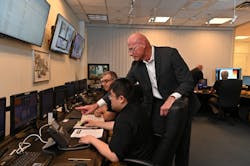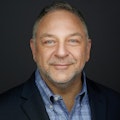Allied Universal’s new protection unit focuses on high-consequence threat mitigation, specialized security
With mass shootings, retail theft, physical attacks on critical infrastructure and more, security companies are facing a more dynamic, multi-faceted threat landscape than ever, and that has spurred some new approaches to planning and mitigating critical threats to life and safety.
Allied Universal took that step in July when it rolled out its new Enhanced Protection Services unit, which offers comprehensive, high-consequence threat mitigation “at every stage of the risk cycle,” from planning and preoperational surveillance to execution and completion, executives say.
Allied’s EPS is the integration of several of the company’s specialized services, including firearm and explosive detection K9 teams; risk advisory and consulting; executive protection; intelligence; disaster and emergency response; chemical, biological, radiological, nuclear and explosives screening; SmartTech screening technology, and active law enforcement.
The business unit is being led by industry expert Glen Kucera, president, Enhanced Protection Services, and boasts more than 17,000 highly specialized security experts, a streamlined suite of services, an expanded national footprint with greater surge capacity and – with more than 3,000 teams – the world’s largest private sector team of explosive and firearm detection K9s.
SecurityInfoWatch sat down with Kucera recently to talk about the EPS unit and its protection mission going forward.
Q: Talk about the growing complexities you’re seeing in security that led to the formation of the Enhanced Protection Services unit.
Kucera: Allied is a $20 billion company that has acquired over a hundred firms, so we've got the greatest subject matter experts under one roof of anybody in the world. Enhanced Protection Services has risk advisory consulting services, which are consulting investigations and intel. We have executive protection, which also includes our embedded armed people. We have the largest active law enforcement company group in the United States. We work at almost all the law enforcement agencies, and then we have the largest K9 program.
We send out Intel alerts every time there's a violent crime that happens, and then our consultants analyze exactly what happened and how do we keep that from happening. So, the basis behind Enhanced Protection Services is to identify the threats. How do you prevent the threat, and how do you come up with a security protocol using all the bundle of services that we have to keep this from happening? We have a customer base that we are providing services for, but what’s behind our group is the use of our subject matter expertise to analyze events and keep those events from happening again.
Q: What’s the differentiator in the services provided? Can you explain how the unit functions?
Kucera: The standard company uses security guards. They observe, they report, and they're somewhat of a visual deterrent, but at the end of the day law enforcement agencies do the response, which is great, but you always lose the transit time. Here's an example in Nashville on March 27 at The Covenant School. At 10:11 a.m., the assailant walks in, and she starts shooting. At 10:23 the officers entered the building and put the assailant down four minutes later. That's phenomenal. Sixteen minutes from the time she walked into the time she was neutralized. But what’s the problem? Six people died.
What we provide is a response team. So, our armed officers, our active law enforcement, even our K9 teams, they're all licensed. They're all ex-military, ex-law enforcement, ex-Secret Service. So they are that layer of protection, so you don't have the 14 minutes. The other thing it affords is a huge visual deterrent. Probably 85% of our business is visual deterrence. So, if that person drives up and they see a K9 team or an armed officer there, there’s almost a one hundred percent chance they're going to go find an easier target because they don’t want to engage.
Typical security relies on law enforcement to react. What we can do is have a visual deterrent. We can engage, we can neutralize, we can minimize, and we can keep that event from happening or keep those six people from getting killed.
Q: Who are some of the subject matter experts that you’re utilizing in this group?
Kucera: We have representation from multiple law enforcement agencies, all branches of the military, Secret Service, TSA. We have former NYPD bomb technicians. When I got hired here, Mike O'Neil was the chairman of the board at MSA, which is a company that was acquired by Allied. Mike was the first chief of counterterrorism for the NYPD. For three years he'd walk into my office with videos of active shooters, of explosives, of violent crimes. We'd pour through these videos, and he'd always say, ‘Tell me what this guy did wrong? What are they missing?’ What do we have here to prevent this?’
That's the mindset of everybody we have here. All of these people have dedicated their entire career to reacting to that event. So now we put our heads together to collectively come up with ways of keeping it from happening, so nobody has to react to that event in the future.
Q: Your colleagues were recently talking about election security and mentioned the uptick seen in requests for enhanced protection. What does the customer base look like for this new unit?
Kucera: First of all, it's heavier in the geographies where there's a higher threat of violence. We're huge in retail where they're looking for that visual deterrent. There are active shooters and shooting incidents in malls about two or three times a month, and now we are providing certain layers of security into the mall environment. We do some of the large athletic teams – for one we have 25 armed and 6 K9 teams, and they're supplemented by their own police officers. In any place where you’re reading those articles and there's active shooter events or mass shootings, all of those are great opportunities for us. And then unfortunately, the bad guys have vivid imaginations. So the sky's the limit.
We have a group of bomb techs here that analyzes images that come over, be it firearms or explosive devices, so we don't allow those into the building. They push a button, it comes over and it gets analyzed by bomb techs. They tell you what's in the package remotely. It's connected through the internet. We run the K9 validation center for a large government agency. We screen every vehicle that comes into World Trade Center. We have technical detection capabilities so we can find lithium batteries. There are a lot of issues with lithium batteries starting fires now. Our narcotics program includes fentanyl.
We do CBRNE screening, which is chemical, bio hazards, radiation, nuclear and explosives, for a lot of the federal agencies. It's not just security guards and people and dogs standing on corners. We work with government agencies, we've helped write programs, and the depth of the subject matter expertise is really immense in this group.
About the Author
John Dobberstein
Managing Editor/SecurityInfoWatch.com
John Dobberstein is managing editor of SecurityInfoWatch.com and oversees all content creation for the website. Dobberstein continues a 34-year decorated journalism career that has included stops at a variety of newspapers and B2B magazines. He most recently served as senior editor for the Endeavor Business Media magazine Utility Products.

